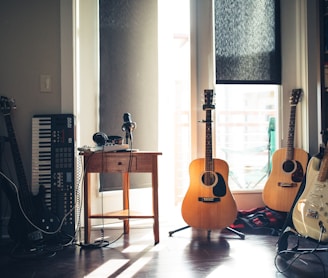How can rhythm be used to create a relaxing effect in music
8/13/20232 min read


Rhythm is an essential component of music that can be used to create a relaxing effect. Here are some ways in which rhythm can be used to create a sense of calmness and tranquility in music:
Slow tempo: Slow tempos can create a sense of calm and relaxation in music. By establishing a slower pulse and rhythm, the listener can enter a more meditative and introspective state[1][6].
Repetition: Repetitive patterns in music can have a soothing effect on the listener, promoting relaxation and a meditative state. By repeating a simple rhythmic pattern, the listener can enter a state of trance-like relaxation[1].
Ambient noise: Incorporating gentle, natural sounds like flowing water or soft wind into the music can enhance the relaxing experience and create a tranquil atmosphere. These ambient sounds can be used to create a sense of calmness and relaxation in the listener[1].
Entrainment: Entrainment refers to the synchronization of bodily rhythms with external rhythms, such as music. Rhythmic patterns in music can entrain the body's internal rhythms, including heart rate and breathing, leading to a state of relaxation[2].
Mimicking bodily rhythms: Rhythm in music can mimic internal bodily rhythms, such as breathing and heartbeat. This mirroring effect can have a calming and grounding effect on the listener, promoting relaxation[5].
By utilizing these rhythmic elements, musicians can create music that induces a sense of calmness and relaxation. Slow tempos, repetitive patterns, and gentle rhythmic accents are often employed to enhance the relaxation experience[1][6]. It's important to note that individual preferences for rhythm may vary, and different rhythmic patterns may have different effects on different individuals.
References:
1. How to Create Emotion in Music: Tranquillity. Recording Arts. https://recordingarts.com/community/tips/samuel-beilman/exploring-tranquility-in-music.
2. Activating and Relaxing Music Entrains the Speed of Beat. PubMed Central. https://www.ncbi.nlm.nih.gov/pmc/articles/PMC3707869/.
3. What makes music relaxing? An investigation into musical elements. Sage Journals. https://journals.sagepub.com/doi/abs/10.1177/0305735618798027.
4. The Power of Melody and Rhythm: How Music Affects Our Brain. Thalia Capos. https://www.thaliacapos.com/blogs/blog/the-power-of-melody-and-rhythm-how-music-affects-our-brain.
5. How Music Can Influence the Body: Perspectives from Current Research. Voices: A World Forum for Music Therapy. https://voices.no/index.php/voices/article/view/2308/2063.
6. Understanding The Fundamentals Of Rhythm In Music. iMusician. https://imusician.pro/en/resources/blog/fundamentals-of-rhythm-in-music.
7 Relaxing And Soothing Calm Piano Music To Help You Sleep. - YouTube
9 "Relax & Unwind: Guided Meditation Music with Soothing Instrumentals" - YouTube
10 Breathe In, Relax, And Be Happy: Deep Sleep Soothing Relaxation Calming Music - YouTube
11 "Calm Your Mind: Gentle Piano Music for Stress Relief" - YouTube
12 Rain Flute - The Most Relaxing Sound In The World. Sleep in 5 Mins - YouTube
14 " Relaxing Nature Sounds and Music for Meditation -Escape to a Peaceful Riverbank " - YouTube
17 " Relaxing Nature Sounds and Music for Meditation -Escape to a Peaceful Riverbank " - YouTube
18 The 5 Minute Sleep Trick That Works Every Time (black Screen & Rain Sounds) - YouTube
